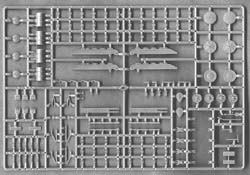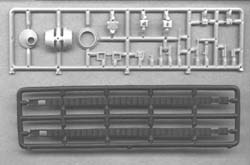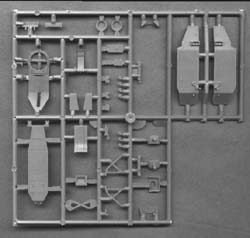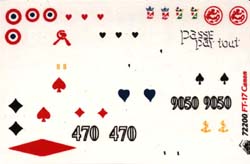| RPM 1/72 Renault FT17 | 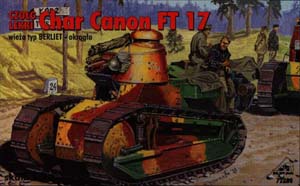 | Introduction The Renault FT17 is the most famous World War I French tank. It is the World first tank which looks like a tank, not like a small barn. Its designer, the French general Jean-Baptiste Estienne, used for the first time in tank history a nowadays obvious feature - a turret containing armament, in this case a 37mm Puteaux gun or 8mm Hotchkiss machine gun. The new tank was very successful. Being fairly well armoured, it was also very hard to hit, being small and maneuverable. Although not fast, the FT 17 was able to cross the difficult terrain and upon its introduction into action on 31st May 1918 proved to be a very effective weapon. Frontline success soon became an economical one: by October 1918 orders for the Renault FT17 reached 7820 tanks just in France, and the tank was exported after the war to Belgium, Brazil, Czechoslovakia, Estonia, Finland, Holland, Lithuania, Latvia, Poland, Spain, Swiss, Sweden and Yugoslavia, also USA license-built modified Renault FT17 as a 'Six Ton' tank. The Kit The Renault FT17 tank kit is the newest 1/72 release of the Polish RPM company, known for their 1/35 kits, but also 1/72 line of the Ford T based military cars. At first no less than seven versions of this kit were released: FT17 with 37mm Puteaux gun in the round (Berliet) turret
FT17 with Hotchkiss machine gun in the round (Berliet) turret
FT17 with 37mm Puteaux gun in the hexagonal turret
FT17 with Hotchkiss machine gun in the hexagonal turret
FT31 French post-war modification
Japan Ko-Gata tank
Soviet - Russkiy Reno Small pictures on the box-side suggests that we will see also US 'Six Ton'' tank, WWI French TSF radio tank and FT17 with smoke screen installation soon. In fact, existing sprues contain some 'surplus' parts, and some of them are definitely parts of the 'Six Ton' kit. The kit comes as three sprues that provide about 200(!) light grey polystyrene parts and a set of the black hard rubber tracks. Every small wheel is moulded as a separate part. The gun is fully detailed with all the parts which are visible only from the interior. Separate tools are included: a pick, a shovel and an axe, and finally you can choose from three optional sets of the big front idler wheels. Every hatch can be shown in open position, although no interior details other than the gun are given. Comparing this to the barely 30 parts of the older Matchbox Renault FT17 1/76 kit, you can easily see the progress on the modeling market nowadays. But this progress demands that the modeler also progress with his modeling skills: RPM kit parts are very highly detailed, but the polystyrene used is unfortunately fragile. A lot of care should be taken during detaching of the lots of smaller details from sprues. Also building of this very detailed and accurate-looking kit won't be an easy, one evening task, as so many parts have to be detached from sprues, cleaned, painted and assembled. But all this should give a lot of fun and even more of pride to every average or more experienced modeler. Decals and painting schemes RPM is generous not only with kit versions and number of parts, but also with the decals and painting schemes included. Although majority of the schemes are typical three colour French camouflages, no less than 15 schemes are available: six French, three US, two Polish and Spanish, one 1944 German and one early '20s scheme from Finland - all this only for the round-turret cannon-armed tank! The decals look very decent, but the film is glossy and a bit thick. Conclusion General quality, level of detail and part number in this very small kit is incredible. As I wrote, this is extremely big advantage for the average and advanced modeler, but for the beginner or gamer it can be a problem. So I recommend this kit very highly, but the beginners who really want to build a Renault tank should at first train a bit on the Matchbox kit. | 







|

